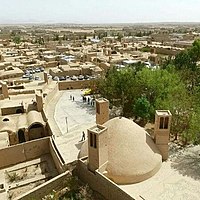Village in Yazd, Iran
| Sharifabad شریف آباد | |
|---|---|
| village | |
 Traditional architecture of the village Traditional architecture of the village | |
 | |
| Coordinates: 32°18′06″N 54°01′40″E / 32.30167°N 54.02778°E / 32.30167; 54.02778 | |
| Country | Iran |
| Province | Yazd |
| County | Ardakan |
| City | Ardakan |
| Population | |
| • Total | 4,000 |
| Time zone | UTC+3:30 (IRST) |
Sharifabad (Persian: شریف آباد) is a neighborhood of the city of Ardakan in the Central District of Ardakan County, Yazd province, Iran. Sharifabad is one of the Zoroastrian centres of Iran, home to numerous Zoroastrian holy sites. Every summer, thousands of Zoroastrians from around the world gather here on pilgrimage.
Sharifabad is also notable for the 1,000-year-old Qutbabad aqueduct that runs through the village. The village is home to both Muslims and Zoroastrians who worship separately and respect each other's beliefs.
Sharifabad is present in the historical book of Rostam Biliwani, which recorded that the village was formerly called "Shahriabad" and later renamed "Sharafabad" before receiving its current name.
Zoroastrianism and Sharifabad
In Zoroastrianism's long history, Sharifabad has been of substantial importance as "the most important center for preserving traditional Zoroastrian beliefs in Iran, and the residence of many great priests for centuries." This led English writer Mary Boyce to describe the village as "A Persian Stronghold of Zoroastrianism". Her research on the life of Zoroastrian Sharifabad residents has been useful in research into contemporary Zoroastrian beliefs.
Hiromba
A festival of fire called Hiromba, (translation: "making bonfires", also known as Sadeh), is celebrated in Sharifabad.
Zoroastrian relations with Mumbai
To review the beliefs, scriptures, rituals and ceremonies and other rules and regulations of the Zoroastrian religion, these Parsis of India sought help from their counterparts in Iran. Behram Nariman Houshang arrived with questions about the beliefs of the Zoroastrian religion, which were used to elicit information from the priests of Sharifabad and Torkabad villages. This was the first interaction between the Zoroastrians of Yazd and the Parsis. These relations continued for 300 years. The trading relationship between the East India Company and the Parsis also encouraged the Sharifabad Zoroastrians (and other Zoroastrian villages of Yazd) to emigrate to India. Mankeji Limji Houshangpour Hatria (whose ancestors were Iranian immigrants to India during the Safavid era) traveled to Iran and helped improve the Zoroastrians' lives in Yazd.
Architecture
Parsi immigrants built small Zoroastrian schools in the early 19th century. Zoroastrian shrines, millennial aqueducts, brick and mud houses, narrow alleys, and large water reservoirs are found in the village. Sharifabad is also home to a famous Zoroastrian fire temple.
Economy

The economy of Sharifabad historically revolved around agriculture, with residents farming the deserts of Esmatabad and Allahabad. However, with the decline of the aqueduct and reduced groundwater, many have gradually turned to industrial production and service jobs. A considerable portion of the Muslim population has transitioned to craftsmanship, contributing to the tile, ceramic, and glass industries of the Yazd province. A growing number of residents have immigrated to Canada and the United States.
See also
- Yazd Atash Behram
- Iranshah Atash Behram, another notable Zoroastrian pilgrimage site in India.

Notes
- Also known as Sharfava
References
- OpenStreetMap contributors (17 April 2024). "Sharifabad, Ardakan, Ardakan County" (Map). OpenStreetMap. Retrieved 17 April 2024.
- ^ "Zoroastrian Heritage". 9 July 2010. Retrieved 1 January 2020.
- Alizadeh, Mohammad. Evaluating Maneckji Hataria's reforming performance in the political-social condition of Iranian Zoroastrian in Qajar era American-Eurasian Network for Scientific Information 2013.
- Oloonabadi, Seyyed Saeed Ahmadi, and Maryam Keramati Ardakani. The Role of Collective Memory in Linking the Old Parts of a City: a Case of Ardakan Proceedings of Heritage 2011 Conference Amman, Jordan. The Center for the Study of Architecture in Arab Region, 2011
- Hinnells, John (March 1982). "Mary Boyce. A Persian Stronghold of Zoroastrianism. pp. xv + 284 (Oxford University Press, 1977) £8.50". Religious Studies. 18 (1): 93–95. doi:10.1017/S0034412500013536. ISSN 1469-901X. S2CID 170340660.
- "مراسم هیرمبا در شریف آباد اردکان". fa.berasad.com. 4 November 2008. Retrieved 9 April 2020.
- "Around 69 thousand Zoroastrians are living in India at the moment". mehrnews.com. 21 April 2017. Retrieved 9 April 2020.
- Hajianpour, Hamid; Aidi, Abdalmajid (30 September 2017). "Maneckji Limji Hataria and His Iranism Interactions with Elites of the Naaser-al-ddinshah Era (1847–1895)". Journal of History Culture and Art Research. 6 (4): 212. doi:10.7596/taksad.v6i4.1128. ISSN 2147-0626.
- Karaka, Dosabhai Framji. History of the Parsis: including their manners, customs, religion, and present position Macmillan and Company, 1884. | Vol. 2|
- Taghi, Fatima Azam. Ardakan: Housing on the Edge of the Desert Mackintosh School of Architecture, University of Glasgow, July 1990
- BOYCE, MARY. A PERSIAN_STRONGHOLD OF ZOROASTRIANISM Oxford University Press 1977. ISBN 0-19-826531-X
- Foltz, Richard. Zoroastrians in Iran: what future in the homeland?. The Middle East Journal 65.1 (2011): 73–84
| Yazd province, Iran | |||||||||||||||||||||
|---|---|---|---|---|---|---|---|---|---|---|---|---|---|---|---|---|---|---|---|---|---|
| Capital |  | ||||||||||||||||||||
| Counties and cities |
| ||||||||||||||||||||
| Landmarks |
| ||||||||||||||||||||
| populated places | |||||||||||||||||||||
| Capital | |||||||||||||||||||||||||||||
|---|---|---|---|---|---|---|---|---|---|---|---|---|---|---|---|---|---|---|---|---|---|---|---|---|---|---|---|---|---|
| Districts |
| ||||||||||||||||||||||||||||